#non-fungibletokens
Explore tagged Tumblr posts
Link
0 notes
Text
The NFT Revolution: Unveiling the Future of Digital Assets
NFT: A Comprehensive Exploration of Non-Fungible Tokens

Nft: A Comprehensive Exploration Of Non-Fungible Tokens
A Glimpse into NFTs In the constantly advancing domain of digital assets.
Non-Fungible Tokens, or NFTs, have recently emerged as a prominent player. The allure of NFTs lies in their uniqueness and ability to assert digital asset ownership. In a digital world where duplication and reproduction are commonplace, NFTs are singular entities. Blockchain technology records the creation of each NFT and subsequent transactions, confirming its authenticity and ownership. What is an NFT? Commonly referred to as NFT. Non-Fungible Token is a digital asset category. It leverages the power of blockchain technology to authenticate ownership and establish the distinctiveness of a specific piece of content or item. NFTs are different than Bitcoin or Ethereum because they are not interchangeable. Each has its value and attributes. The Journey of NFTs Although NFTs have been around since 2014, they only began to capture substantial attention in 2017, following the introduction of CryptoKitties. This blockchain-based virtual game allows players to adopt, raise, and trade virtual cats. Each CryptoKitty is an NFT with its unique visual appearance and attributes ("attributes"). Since then, NFTs have expanded beyond digital cats. Digital artists, in particular, have embraced NFTs. Before NFTs, digital artists found it difficult to sell their work due to the ease of replicating digital art. NFTs allow for the tokenization of digital art, enabling the creation of a digital certificate of ownership. This certificate can be bought and sold, allowing for digital art trade. As a result, artists can now sell their work directly to consumers without needing galleries or auction houses, allowing them to keep a more significant portion of the profits from sales. The Technological Foundation of NFTs NFTs use blockchain technology and cryptography, the same decentralized and distributed ledger system supporting cryptocurrencies. The most common blockchain for NFTs is Ethereum due to its support for the ERC-721 standard, which facilitates the creation of NFTs. The Ongoing Evolution of NFTs As we delve deeper into the potential of NFTs, it's clear that they represent a new frontier for digital assets. As the realm of NFTs progresses, we can anticipate the emergence of novel applications and use cases. The possibilities are limitless, from fractional ownership of NFTs, which would allow multiple individuals to own a part of a single NFT, to integrating NFTs with virtual and augmented reality. As with any emerging technology, there will be challenges and setbacks, but the innovation potential is immense.
Understanding the Value of NFTs

Understanding The Value Of Nfts The Impact of Scarcity and Uniqueness on NFT Value Apart from their uniqueness, the scarcity of NFTs also significantly contributes to their value. For instance, an artist may mint a limited number of NFTs for a specific artwork. This limited availability can create a sense of scarcity, thereby increasing the value of these NFTs. Despite the potential benefits, investing in NFTs is not without risk. The worth of an NFT is primarily subjective and can fluctuate significantly. It renders the NFT market highly speculative and potentially unstable. It is similar to the concept of limited editions in the physical art world, where a smaller print run often leads to higher prices.
How Do NFTs Generate Revenue?

How Do Nfts Generate Revenue? The Role of Speculation in NFT Trading Speculation plays a significant role in the NFT market. Many buyers acquire NFTs, hoping their value will appreciate over time. This speculative nature can lead to high volatility in the NFT market, with prices fluctuating dramatically in a short period. However, it's important to note that, like any investment, buying NFTs involves risk, and there's no guarantee of profit-making. NFTs: A Mechanism for Digital Ownership NFTs embody a new form of digital ownership that is distinctive, verifiable, and exchangeable. NFTs represent a significant shift in our understanding of digital ownership. In the past, digital assets were quickly replicable and challenging to own. With NFTs, digital assets can be unique, and the blockchain can prove ownership. It opens new digital art, music, gaming, and more possibilities.
Why Would Anyone Invest in an NFT?

Why Would Anyone Invest In An Nft? It might seem puzzling to some that people are willing to spend large sums on digital assets that anyone can view or download at no cost. So, why do people invest in NFTs? The Appeal of Digital Collectibles Many individuals are drawn to investing in NFTs due to the allure of possessing a one-of-a-kind digital collectible. Like physical collectibles, digital collectibles can bring their owners joy and appreciate value over time. NFTs as a Form of Investment Some people invest in NFTs as a form of investment. They hope that the value of the NFT will appreciate over time, allowing them to sell it for a profit in the future. Even the real estate market could be transformed by NFTs. Virtual real estate, represented by NFTs, is already being bought and sold. Technologies are continuous. We could see a future where virtual real estate becomes just as valuable, if not more so, than physical real estate. It would allow people to own and trade properties in virtual worlds, opening up new possibilities for the real estate market. NFTs and the Desire for Uniqueness NFTs cater to the human desire for uniqueness and individuality. Owning an NFT means owning a unique piece of digital content that no one else has. The music industry is another sector that's being revolutionized by NFTs. Musicians can create NFTs of their albums or songs, providing a new revenue stream. An instance of this would be when Kings of Leon, a rock band, released their latest album as an NFT. It made them the first band ever to do so. It provides a new way for artists to monetize their work and allows fans to own a unique piece of the artist's work. Beeple's NFT Artwork One of the most notable examples of NFTs in art is the digital artist Beeple (real name Mike Winkelmann). In March 2021, Beeple's artwork "Every Day: The First 5000 Days" was sold as an NFT for $69 million at Christie's auction house. This sale marked a significant moment in the art world, as it was the first time a major auction house had sold a purely digital artwork.
The Risks and Obstacles of NFTs

The Risks And Obstacles Of Nfts Legal and Regulatory Obstacles for NFTs As with any emerging technology, NFTs face many legal and regulatory challenges. One such challenge revolves around the ambiguity of intellectual property rights concerning NFTs. When you purchase an NFT linked to a piece of digital art, does that mean you own the copyright to that art? Generally, the answer is no. What you own is a token that confirms your ownership of a copy of that art, while the copyright remains with the original artist." It can result in confusion and potential legal conflicts. Moreover, NFTs will likely draw more regulatory scrutiny as they gain popularity. Governments globally are still determining how to regulate cryptocurrencies, and NFTs will probably face similar examinations. Besides, there are worries about the environmental impact of minting NFTs, as the process demands considerable energy and adds to the blockchain industry's carbon footprint. Understanding NFT Marketplaces With NFT marketplaces, you can buy, sell, and trade NFTs. These platforms utilize blockchain technology to verify the authenticity of digital assets and confirm ownership by their legitimate owners.NFTs are particularly interesting when it comes to virtual real estate. In virtual worlds like Decentraland and Cryptovoxels, users can buy, sell, and trade land parcels in NFTs. These virtual properties can be developed like real-world properties, with users building virtual homes, businesses, and art installations on their digital land. Decentraland In Decentraland, a virtual reality platform, users can buy, sell, and trade virtual real estate, represented as NFTs. The value of these virtual properties can increase based on various factors, such as their location in the virtual world or the developments around them.
Which Coin is Used for NFT?

Which Coin Is Used For Nft? Although NFTs can technically be constructed on any blockchain that accommodates intelligent contracts, most NFTs are built on the Ethereum blockchain. Ethereum and NFTs: A Common Pairing Intelligent contracts support has made Ethereum the most commonly used blockchain for NFTs. These contracts are self-executing and have the terms of the agreement directly written into code, enabling the creation and trading of NFTs. Other Cryptocurrencies Used in NFT Transactions While Ethereum is the most common, blockchains like Binance Smart Chain (BSC), Flow, and Tezos also support NFTs. The choice of blockchain can depend on various factors, such as transaction costs and the community around the blockchain.
NFTs in Different Industries

Nfts In Different Industries The application of NFTs extends beyond the realm of digital art. They are making significant inroads into various sectors, including music and real estate. Additionally, the world of collectibles has embraced NFTs. Digital collectibles, like CryptoPunks and NBA Top Shot moments, have sold for astronomical sums. These collectibles are attractive because they are both scarce and verifiable. The blockchain records each transaction, proving the rarity and ownership of these digital assets. It has created a booming market for digital collectors. NFTs in the Art World In art, NFTs have opened up new possibilities for digital artists to monetize their work. Artists can mint their digital art as NFTs and sell them directly to collectors, bypassing traditional art galleries or auction houses. Celebrities Releasing NFTs Celebrities like Paris Hilton, Snoop Dogg, and Tony Hawk have jumped on the NFT bandwagon, releasing their own NFT artworks and collections. It has brought more attention to the NFT market and shown the potential for using NFTs creatively. NFTs in the Music Industry Within the music sector, musicians can create NFTs of their music and sell them straight to their audience. This approach offers an additional income source for artists and presents a unique and innovative way to interact with their fanbase. For example, an artist could release a limited edition album as an NFT, allowing fans to own a unique piece of the artist's work. NFTs in the Gaming Industry The gaming industry is being transformed by NFTs, which offer gamers a novel approach to possessing their in-game assets. In traditional video games, players can spend money on in-game items but don't truly own them. The game company does. If the game shuts down or the player's account is closed, they lose access to these items. With NFTs, players can have actual ownership of their in-game items. They can trade them with other players, sell them for real-world money, or even take them to other games if they support the same NFT standards. NBA Top Shots NBA Top Shots, officially licensed NFTs of NBA highlight clips, have become a popular form of digital collectible. Like traditional sports cards, fans can buy, sell, and trade these clips.
The Future of NFTs

The Future Of Nfts The Future of NFTs in the Digital Economy As our world becomes increasingly digital, NFTs are expected to impact digital assets' future significantly. They are already making a significant impact in the growing creator economy, offering a novel way for creators of all types to monetize their work and connect with their audience. For example, authors could tokenize their articles or books, selling them directly to their readers as NFTs. It could disrupt traditional publishing models, allowing creators to maintain more control over their work and earn more from their creations. NFTs signify a shift towards digital ownership and have the potential to transform how we buy, sell, and trade digital content. In gaming, NFTs could revolutionize how in-game items are owned and traded. Currently, most in-game items are tied to a specific game and cannot be transferred out. However, with NFTs, these items could become interoperable, meaning they could be used across different games. It would give players more ownership over their in-game items and could create entirely new economies within and between games. Predictions for the Evolution of NFTs As the NFT market evolves, we expect to see more innovation and new use cases for NFTs. It could include more interactive NFTs, NFTs with utility, and NFTs that integrate with other technologies, such as virtual reality and augmented reality. For example, imagine owning an NFT representing a virtual piece of art you can display in your virtual reality home. Or an NFT that gives you access to exclusive content or experiences, such as a virtual meet-and-greet with a celebrity. NFTs and the Future of Social Media While the market is still young and volatile, the potential of NFTs is vast. Social media is another area that NFTs could transform. Imagine a future where social media users can own and trade their content as NFTs. It could create a new economy around user-generated content, allowing users to profit from their creativity and influence. It could also lead to more equitable social media platforms, where users are rewarded for the value they create.
Navigating the NFT Landscape

Navigating The Nft Landscape While the world of NFTs can be exciting, it's also complex and rapidly changing. Here are some tips for navigating the NFT landscape: Do Your Research Before buying an NFT, it's essential to do your research. Understand what you're buying and who you're buying it from. Look into the artist or creator, and make sure they're reputable. Also, understand the terms of the sale. Do you own the copyright to the digital asset or just the token? Understand the Risks Investing in NFTs can be risky. The value of an NFT can fluctuate widely, and there's no guarantee that you'll be able to sell it for a profit. Also, as with any digital asset, there's the risk of hacking or theft. It is crucial to utilize a secure wallet and safeguard your private keys to ensure the safety of your assets. Stay Informed The world of NFTs is rapidly evolving, with new platforms, artists, and use cases constantly emerging. It is highly recommended to stay up-to-date with NFT news sources, actively participate in online communities, and attend virtual events and meetups. Doing so can ensure you are well-informed I am well-informed about current trends and advancements. in the NFT space. Keeping a finger on the pulse of the industry will also help you make well-informed choices when purchasing, selling, or trading NFTs. So, take advantage of these valuable opportunities to expand your knowledge and network. Key Takeaways About NFTs NFTs represent a new form of digital ownership that is unique, provable, and tradeable. They have opened up new possibilities for artists, creators, and collectors and have the potential to impact various industries. As we delve deeper into NFTs, we realize they're pioneering a new frontier in digital assets. They offer a way to authenticate and monetize digital assets in a way that was not previously possible. Beyond art, music, and gaming, NFTs could also play a significant role in the future of digital identity as we spend more of our lives online, proving our identity securely and reliably becomes increasingly essential. NFTs could represent digital identities, with each person having a unique NFT representing their online identity. It could help reduce fraud and improve security in online transactions.
The Role of NFTs in Shaping the Future of Digital Assets
Read the full article
#BlockchainTechnology#Cryptocurrency#DigitalArt#DigitalAssets#DigitalOwnership#GamingIndustry#Investment#MusicIndustry#NFT#NFTs#Non-FungibleToken#Non-FungibleTokens#VirtualRealEstate
0 notes
Text
Understanding Web 3.0: A Shift Towards Decentralization and User Sovereignty

The digital world is on the brink of a paradigm shift as we transition from Web 2.0 to Web 3.0, also known as Web3. This shift promises a more decentralized, transparent, and user-centric version of the internet, profoundly changing our online interactions.
Decentralization: Power to the People
A pivotal feature of Web3 is decentralization, a direct contrast to the current Web 2.0 landscape dominated by tech behemoths such as Google and Facebook. Web3 envisions an internet where users, rather than centralized entities, have control. Enabled by blockchain technology, this model distributes power among the users, allowing them to own their digital footprints.
Blockchain Technology and Cryptocurrencies: The Backbone of Web3
Web3 fundamentally relies on blockchain technology, a type of distributed ledger that maintains records across multiple systems. With its transparent and immutable nature, blockchain facilitates decentralized applications (dApps), pushing the boundaries of traditional online services. Cryptocurrencies like Bitcoin and Ethereum, built on this technology, play a significant role in transactions within the Web3 ecosystem.
Smart Contracts: Code as Law
Web3 incorporates smart contracts, code-based agreements that autonomously execute transactions when specific conditions are fulfilled. They remove the need for intermediaries, fostering transparency and efficiency. Smart contracts bring a new level of automation and trust to online transactions, from simple transfers to complex contractual agreements.
Interoperability: The Seamless Web
Web3 emphasizes interoperability, fostering a digital environment where data and assets can freely move across platforms, applications, and blockchains. This seamless interaction is expected to promote innovation, user convenience, and an overall improved digital experience.
Privacy and Data Ownership: Taking Back Control
A core proposition of Web3 is to give users control over their data. Unlike Web 2.0, where tech companies own and monetize user data, Web3’s decentralized architecture seeks to return data ownership to the users. This move signifies a monumental shift in privacy and data rights, fostering an online ecosystem that respects user privacy.
Decentralized Finance (DeFi): Revolutionizing Finance
A prominent subsector of Web3, Decentralized Finance (DeFi), aims to recreate and improve traditional financial systems in a decentralized environment. From loans to insurance to trading, DeFi platforms offer financial services on the blockchain, democratizing access to financial systems and services.
Non-Fungible Tokens (NFTs): The Dawn of Digital Ownership
NFTs, or Non-Fungible Tokens, are unique digital assets residing on a blockchain. They have gained significant attention for their role in digitizing arts, music, and other forms of creative work, representing a new way of asserting ownership and provenance in the digital realm.
The Web3 Technology Stack: Building the Future Web
Technologies such as the InterPlanetary File System (IPFS), a peer-to-peer network for storing and sharing data, and the Ethereum blockchain, a platform for creating dApps, are part of the foundational tech stack for Web3. These technologies underpin the new wave of decentralized applications and platforms shaping the Web3 landscape.
DAOs (Decentralized Autonomous Organizations): The Future of Organizations
Decentralized Autonomous Organizations (DAOs) are one of the new entities birthed in the Web3 space. DAOs are fully automated and decentralized, running on smart contracts on a blockchain. The decision-making mechanisms of DAOs are governed by programming, thereby eliminating the need for a central authority. DAOs represent a radical shift in the conception of organizational structures, fostering an era of automation and decentralization.
Identity and Reputation Systems: Trust in a Decentralized World
In the realm of Web3, identity and reputation systems are anticipated to play a crucial role. The notion of self-sovereign identity empowers users with absolute control over their personal data, while decentralized reputation systems help to establish trust within the network. These systems will be vital in securing user trust and fostering cooperative behavior in the network.
User Interface and Experience: Bridging the Complexity Gap
The interface and user experience in Web3 are expected to be fundamentally different from Web2.0 due to the technical complexities of blockchain and cryptocurrencies. The challenge for Web3 developers is designing user-friendly interfaces that effectively veil these complexities, ensuring a seamless user experience.
Token Economy and Incentives: Reciprocity in Web3
Web3 is likely to heavily depend on tokens as a basis for its economy. These digital assets are used to incentivize and reward users for their contributions to the network, fostering a more reciprocal relationship between platforms and their users.
Internet of Things (IoT) and AI Integration: Automation and Intelligence in Web3
The integration of IoT and AI technologies in the Web3 framework unlocks novel possibilities for smart and automated applications. These integrations can revolutionize various sectors, ranging from supply chain management to home automation, driving efficiency and productivity.
Role of ISPs: Redefining Internet Access
In the current internet infrastructure, Internet Service Providers (ISPs) play a pivotal role in managing and controlling access to the web. However, with the advent of Web3's decentralization, the role of ISPs may undergo significant changes, potentially diminishing their importance.
Security: Safeguarding the Decentralized Web
Despite the inherent security of blockchain technology, the applications built on it may have vulnerabilities. For instance, smart contracts can present exploitable weaknesses for hackers. As the Web3 ecosystem expands, the need for robust cybersecurity measures also grows in importance.
Digital Divide: The Inclusivity Challenge
There's concern that the transition to Web3 could worsen the existing digital divide if access to Web3 necessitates certain technical expertise or financial resources that not everyone possesses. Therefore, ensuring that Web3 is inclusive and accessible to all is a pressing challenge that needs concerted efforts to overcome. With these new integrations, Web3 is set to disrupt the digital world in unimaginable ways. It's a complex and exciting new frontier that promises to revolutionize how we interact with the internet and each other. While there are numerous challenges to address, the potential for a more equitable and user-centered internet makes this journey worthwhile.
Challenges Ahead: Scalability, Energy, Regulations, and Adoption
Despite its promise, Web3 faces significant challenges. Scalability issues, energy efficiency concerns, regulatory uncertainties, and user adoption hurdles are considerable roadblocks. As a rapidly evolving field, Web3 requires ongoing development, refinement, and robust dialogue among stakeholders to address these challenges. The transition from Web 2.0 to Web3 signifies an important evolution in the digital world. It embodies a move towards a more user-centric, decentralized, and transparent internet. While the road ahead may be fraught with challenges, the potential rewards of a more equitable, open, and user-controlled web are immense. Read the full article
#blockchaintechnology#Cryptocurrencies#DataOwnership#Decentralization#DecentralizedFinance#interoperability#Non-FungibleTokens#privacy#smartcontracts#Web3.0
0 notes
Text
Create an NFT store
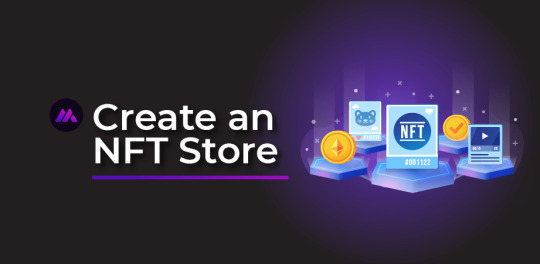
NFTs — Non-fungible tokens have made artists and creators redefine their work. Those with creative abilities have a newer way to earn while pursuing their passion. As a result, NFT became the word of the year 2021 in the Collins dictionary. NFTs led to the term ‘Digital Artists’ - a new category added to the clan of talented craftsmen. The uniqueness of NFTs has made them more attractive and useful. If you are on this page, you are certainly an NFT evangelist looking for ways to enhance your treasure of NFT collections. Imagine how it would feel to create NFT store wherein you could buy, sell or trade NFTs!
What is an NFT store?
Do you want to shop for NFTs? Looking at enhancing your NFT collection? Or, plan to sell some of your NFTs? Check out the best NFT Marketplaces in our blog. Then, you are at the right place. However, first things first. Let’s understand the basics of the NFT marketplace. Say you created an NFT and want to sell it. How do you do that? Create NFT store. NFT store is the place where you put up your creation for sale. Well, it is essentially a platform offering various collections of NFTs. These collections could span multiple kinds of NFTs, as in, they could be art, images, audio, videos, music, tweets, and the list is endless. Ideally, they bring together creators and crypto lovers to a common platform where they can create and trade in NFTs. They are like auction houses where they are bid on like real artwork. The highest bidder is rewarded. As the number of bidders increases, the price of the NFT soars higher. As a result, it creates scarcity of the artwork, thereby enhancing its value in millions! They are built on the blockchain platforms which support them, Ethereum, for instance. You could create NFT store and buy or sell NFTs here. Usually, these stores offer a highly intuitive, user-friendly interface with sufficient payment tokens. Besides, NFT marketplaces have various NFTs ranging from gaming to art and music. Numerous NFT marketplaces cater to the multitude of interests of artists and creators worldwide.
Pre-made NFT Store
NFT marketplace is one of the key features offered on certain blockchain platforms. You can easily access these stores and start trading in NFTs. Some examples of NFT Webshops include - Opensea on Ethereum, Solsea on Solana, and BNB on Binance. The NFT webshops have diverse collections and display them methodically, classified based on top sales or top-performing creators or best collections and such. Besides, these platforms provide useful search options and filter/sort criteria to narrow down your searches. The basic components of an NFT webshop include - Attractive Storefront The marketplace displays artwork, details of bids, price history, top-performing collections, and more to attract and engage the users. Easy listing Options Easy-to-create listings are vital to an NFT marketplace. The users would be interested in listing their NFTs for sale. Usually, they offer very convenient listing choices. Quick Filters/Searches To make your journey through the store enjoyable, they offer quick filters to sort the items. Also, there are advanced search options to help you find your selections efficiently. Push Notifications To ensure you stay updated with trending items and collectibles as a registered user on the NFTmarketplace, the store sends push notifications with recent updates, events, and more. Multiple Wallet Options Most NFT web shops offer you multiple wallet choices to conveniently trade and shop your favorite NFTs. Ratings & Reviews These stores help beginner NFT buyers with ratings and reviews put against each NFT. By skimming through this info, someone new to the marketplace can understand what to buy and what not to.
How to buy NFTs on NFT marketplace?
Usually, they offer a web link or app. You could browse the store to skim through the huge variety of choices. The NFT Webshops offer a user-friendly interface with easy-to-navigate tabs. Buying NFTs on stores consists of a few simple steps. Add cryptos to your wallet Depending on the platform you are buying the NFT from, check out for the cryptos they accept. Then, make sure you have an account created on that blockchain platform. Else, first, sign up to create an account. Next, you need to add the requisite cryptocurrency to buy the NFT. If you have cryptos bought from third parties, first deposit them into this account. Access the NFT webshop Usually, most of these stores offer two ways to access them. First, you may use a desktop browser to reach the store from your laptop. Alternatively, most stores have their user-friendly apps, too. Choosing your NFT NFT marketplace offers an immense treasure of options to choose from. The user-friendly interface shows the tabs that take you to various sections such as gaming NFTs, art, etc. It’s fun browsing through the awesome NFTs on a store! Buying your NFT In the first case, as the name suggests, you buy the NFT at a fixed price. In the second, you may have options to place a bid. Usually, once bids are placed, they cannot be canceled. Your funds get locked until the bid ends or a new one is placed.
How to sell NFTs on NFT marketplace?
Similar to buying an NFT, you can sell them too and make profits. To sell, you need to follow a few simple steps: Set up your wallet Once you have your crypto wallet, link it to the store. Do check out the kinds of wallets that the platform supports. Prepare your collection Usually, NFT webshops will have a section to create your collections. You could use your social media links and images to complete your profile. Add your NFT Upload your NFT digital file, audio, video, music, or art images. Add a title and a brief description, tag properties, and stats to your NFT. Put it up for sale Finally, choose how you would like your NFT to be sold. Select an option such as fixed-price listing or auction etc. These are excellent avenues for those NFT aficionados interested in trading. We, at iMintify, offer you the benefits of a well-designed, robust, and easy-to-use NFT webshop — all customized to your needs. Similar to an NFT website, which just goes well with one NFT collection, you can have your own NFT marketplace, supporting numerous NFT collections! Join us. Bring us your requirements, and we will create NFT store for you, compatible with your business and embellished with our ideas! Read the full article
#nft#nftart#nftartists#nftcollectibles#nftcollection#nftcollectors#nftdevelopment#nfteducation#nftindustry#nftmarketplace#nftminting#nftwebsite#non-fungibletokens
1 note
·
View note
Text
NFTs: Why it is not a boring Katha yet
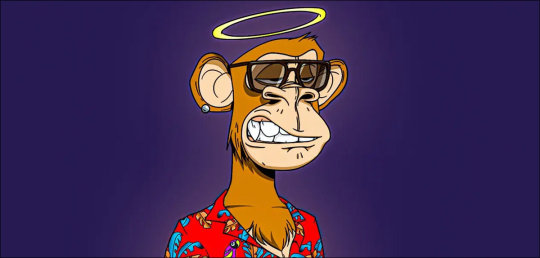
Sairaj Iyer investigates the fascinating world of non-fungible tokens, and explains why they continue to be a realm filled with potential. Read More. https://www.sify.com/iot/nfts-why-it-is-not-a-boring-katha-yet/
0 notes
Text
Cryptocurrency and Blockchain Technology

Cryptocurrency and blockchain technology have piqued the interest of investors, technologists, and legislators alike, promising to transform the financial landscape. This article will look at the latest trends, advancements, and prospective effects of cryptocurrency and blockchain technology on banking.
The Evolution of Cryptocurrency
Bitcoin, created in 2009 by an anonymous individual or group known as Satoshi Nakamoto, marked the beginning of the cryptocurrency era. Since then, thousands of alternative cryptocurrencies, or altcoins, have emerged, each with unique features and purposes. Growth of Blockchain Technology Blockchain, the underlying technology behind cryptocurrencies, has also evolved significantly. Originally devised as to record Bitcoin transactions, blockchain technology is now being explored for a wide range of applications beyond digital currencies.
Latest Trends in Cryptocurrency
Decentralized finance, or DeFi, has emerged as a major trend in the bitcoin sector. DeFi platforms seek to duplicate traditional financial services including lending, borrowing, and trading without the use of intermediaries such as banks. Non-Fungible Tokens (NFTs) Non-fungible tokens (NFTs) have received a lot of interest due to their capacity to represent ownership of unique digital goods like artwork, collectibles, and digital real estate. The NFT industry has expanded rapidly, attracting artists, investors, and collectors alike. Central Bank Digital Currencies (CBDCs) Central banks are looking at the prospect of releasing their digital currency, known as central bank digital currencies, or CBDCs. These digital currencies seek to increase efficiency, lower expenses, and promote financial inclusion.
Developments in Blockchain Technology
Blockchain developers prioritize interoperability and scalability. Projects such as Polkadot, Cosmos, and Ethereum 2.0 are developing ways to improve blockchain network interoperability and scalability. Enhanced Security and Privacy Advances in cryptography approaches and privacy-preserving technology improve blockchain network security and privacy. These advancements are critical to establishing trust and confidence in blockchain-based systems.
Potential Impact on the Financial Landscape
Cryptocurrency and blockchain technology can potentially disrupt established banking institutions by providing faster, less expensive, and more inclusive financial services. This disruption could result in a shift of power in the banking industry. Financial Inclusion and Access Blockchain technology has the potential to provide financial services to the unbanked and underbanked populations worldwide, opening up new opportunities for economic empowerment and financial inclusion. Regulatory Challenges and Opportunities The rapid growth of cryptocurrency and blockchain technology has prompted governments and regulatory bodies to develop frameworks and policies to address concerns such as consumer protection, money laundering, and tax evasion. Clear and balanced regulation is essential to foster innovation while ensuring investor protection and financial stability.
Conclusion
Finally, cryptocurrencies and blockchain technology are fundamentally changing the financial world. The future of finance appears to be becoming more decentralized, digital, and inclusive, with the rise of non-fungible tokens, the research of central bank digital currencies, and advancements in blockchain technology. As these technologies advance and develop, their impact on the financial environment will only increase, ushering in a new era of innovation and opportunity. Read the full article
#Blockchain#BlockchainApplications#BlockchainDevelopments#BlockchainSecurity.#CentralBankDigitalCurrency(CBDC)#CryptoInvestments#CryptocurrencyRegulation#CryptocurrencyTrends#DecentralizedFinance(DeFi)#DigitalAssets#DigitalCurrency#FinancialInnovation#FinancialTechnology(FinTech)#Non-FungibleTokens(NFTs)
0 notes
Text
Ethereum Smartphone: A Game-Changer in the Web3 World
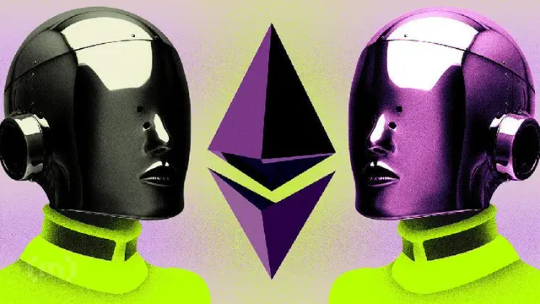
In the fast-evolving realm of Web3 technology, the Ethereum smartphone has emerged as a true game-changer. Within a mere 24 hours, this innovative device, based on the Google Pixel 7a and fueled by the unique open-source operating system known as ethOS, managed to completely sell out its initial 50 units. Let's delve deeper into what makes this Ethereum smartphone a standout in the ever-competitive market.
The EthOS Operating System: Redefining Mobile Experiences
The "Ethereum Phone" derives its name from the Ethereum operating system, which goes by the abbreviation ethOS. Interestingly, 'ethOS' not only represents Ethereum but also carries the Greek connotation of 'character.' This double meaning encapsulates the uniqueness of this device, boasting an ethOS operating system designed to redefine mobile experiences. One of the standout features of this smartphone is its built-in Ethereum light client. This specialized functionality transforms the device into a "light node" on the Ethereum network, enabling independent block validation. This unique capability sets it apart from other Web3 smartphones and enhances its performance in handling Ethereum-based transactions and smart contracts.
Seamless Integration: Payments, Messaging, and Ethereum Name Services
The Ethereum smartphone doesn't stop at Ethereum integration; it goes a step further by providing an array of built-in tools for effortless payment processing and seamless messaging. What sets it apart is its native integration with Ethereum Name Services (ENS), simplifying payment procedures for users. Additionally, it offers support for Ethereum Virtual Machines (EVM) and Layer 2 scaling networks, ensuring compatibility with a wide range of decentralized applications (DApps).
Exclusive Access Through NFTs

ethOS NFT. Source: OpenSea Securing one of these coveted Ethereum smartphones required prospective buyers to obtain an ethOS non-fungible token (NFT) during the pre-sale period. Owning this NFT acted as a ticket to reserve their Ethereum smartphone. However, the process was not without its challenges, as fake NFTs flooded the market on OpenSea, the largest NFT trading platform. For some enthusiasts, the cost of entry was steep, with ethOS NFTs commanding prices of up to three Ethereum (ETH), equating to nearly $5,000. This stands in stark contrast to the standard Google Pixel 7a, priced at a modest $499 in the US. The exclusivity and blockchain integration of these smartphones have driven their value skyward, with the price differential being a notable 10x.
Competition Heats Up in the Web3 Space
While the Ethereum smartphone made waves with its successful pre-sale, the Solana (SOL) smartphone faced a more challenging market entry. Records show that just over 2,000 units were sold since its release, according to Flipside records. To combat this, Solana Labs took drastic measures, reducing the price from $1,000 to $599, aiming to boost the appeal of their user-friendly crypto phone. This price adjustment came in response to the impending launch of the Ethereum smartphone, scheduled for the fall of 2023.
Conclusion
In conclusion, the Ethereum smartphone, powered by ethOS, is undeniably a trailblazer in the Web3 arena. Its innovative features, seamless integration with Ethereum's ecosystem, and exclusivity via NFTs have positioned it as a frontrunner in the competitive market. As the Web3 landscape continues to evolve, it will be fascinating to witness how this groundbreaking device shapes the future of mobile blockchain technology. For more articles visit: Cryptotechnews24 Source: beincrypto.com
Related Posts
Read the full article
#blockchainintegration#CryptoNews#Ethereum#Ethereumintegration#EthereumNameServices#Ethereumsmartphone#EthereumVirtualMachines#ethOSoperatingsystem#NFTs#non-fungibletoken#OpenSea#Web3technology
0 notes
Text
Before learning about non-fungible tokens (NFT), calligraphy artist Sarah Richardson (also known as Sarah Script) had been posting Instagram videos of her work for almost seven years. "You only have one opportunity to get calligraphy properly. You have to stay on the ground, she sAId. "I would spend hours filming videos of one or two words that would only be 15 seconds long after editing."

0 notes
Text
Legality of NFTs in India as per IPR: All You Need to Know

This article on 'NFTs legality as per IPR: All You Need to Know' was written by Madiha Khan, an intern at Legal Upanishad.
Introduction
NFTs, or non-fungible tokens, are a type of cryptocurrency token that comprises a variety of physical and virtual properties. It includes images, gifs, drawings, movies, multimedia recordings, and other media. Each NFT is distinct and regarded as a rarity. A blockchain digital journal is used to document NFTs in a way that confirms their originality and legitimacy. Blockchain technologies are digital blocks that keep track of all the transactions involving the virtual digital asset, also known as VDA, where the data and title of NFTs holders are kept. The Intellectual property laws apply to royalty-free licenses on how their CryptoPunks may be used in derivative works belonging to NFT holders.
NFTs procedure
After establishing an NFT, the "smart contracts" replace the current system for the storing and exchanging of digital assets. A smart contract can be thought of as software programs connected to the NFT that includes information, guidelines, and rights relating to the primary asset joined to the NFT, like royalties from music, bonds, invoices, and so on. Thus, the "Tokenization" mechanism enables the original token creator to profit financially from future NFT buyers, which is made possible by the token's uniqueness. Authors can receive royalties on successive future sales of the original work within an NFT on popular NFT platforms like NiftyGateway, Rarible, OpenSea, etc
Intellectual Property Protection
NFTs might be covered by intellectual property rights such as copyrights, design, and trademark protections. As a result, buyers of NFTs should be aware of any associated intellectual property rights. Although design patents may be able to protect some NFT-protected assets, those NFTs would still be restricted by the same legal restrictions as conventional products and services. However, some NFTs may be subject to trademark and copyright protection. Plausibly, NFTs could be tied to a legal right. The right to own one copy of the creative work (in the same way as one may own any goods or asset) and the freedom to make replicas and produce variants, however, are two distinct rights.
Copyrights protection
Even though NFTs are a pretty modern and somewhat unusual sort of art, copyright law will perceive them in the same manner as any other conventional works of art. They instantaneously become the owner of that work. Selling the printed copy or tangibly printed NFTs is not allowed, however, printing a non-fungible token is much simpler. Certain NFTs violate copyright laws by employing works of art that have been stolen from creators or well-known pieces that the NFT developers are not affiliated with and do not have permission to use. Copyright infringement can also occur even when these works are copied for NFT marketing purposes. An NFT can be screenshotted only for private use and infringement can occur if you resell it, claim ownership of it, share it online or elsewhere, or create a copy of the work for commercial purposes. If such actions are done, the NFT's proprietor may file a lawsuit against the infringer for copyright infringement, or be charged with additional crimes. Where copyright is concerned the title of the core rights can only be transferred to the NFT holder if the original work's author expressly approves doing so. Based on the terms of the transaction, an NFT owner may not be permitted to recreate, advertise copies, display the work publicly, showcase, or make backup copies of the original property only when copyright is transferred via licensing. Under Section 14 of the Indian Copyright Act of 1957, the copyright owner is granted several privileges, including the ability to make copies and alterations. When a customer purchases an NFT that correlates to artistic activity, they also receive a copy of the underlying work (in some digital format, such as.jpeg,.pdf, or.mp4) in addition to the NFT itself, or tokens. Any unauthorized use of an NFT and sending it to a client could be construed as copyright infringement. This goes for any unlawful distribution, copying, or adaptation of an NFT. Imposing IP rights against a buyer after an NFT sale can be difficult because NFT ownership is decentralized and blockchain transactions are immutable. Similar to a bank account, an NFT is typically associated with a mobile wallet address, but without strong digital evidence, identifying the wallet owner could be challenging. Thus, utilizing legally powerful takedown notices might stop the NFT from ever being sold.
The legality of NFTs
If NFTs were classified as derivatives, dealing in them would be prohibited in India since, in accordance with Section 18a of the SCRA (securities contract regulation act), such activity is not permitted on the internet. They are regarded as valid only when derivative transactions are traded on a lawful stock exchange. Commercial transactions known as derivatives generate their value from an underlying asset. These could include interest rates, indexes, commodities, currencies, exchange rates, and equities. By wagering on the appreciation of the underlying asset, these investment products assist in generating income. The person who mints/makes the NFT is the rightful owner of it. Therefore, in reality, the NFT's owner is not always the author/creator. Nonetheless, minting an NFT of work for that another party owns the rights will effectively be regarded as the work's theft and a copyright violation. In 2018, the Reserve Bank of India (RBI) tried to outlaw the usage of bitcoin or cryptocurrencies. In reaction to the aforementioned order, a few businesses that run online crypto trading platforms and other groups filed appeals.
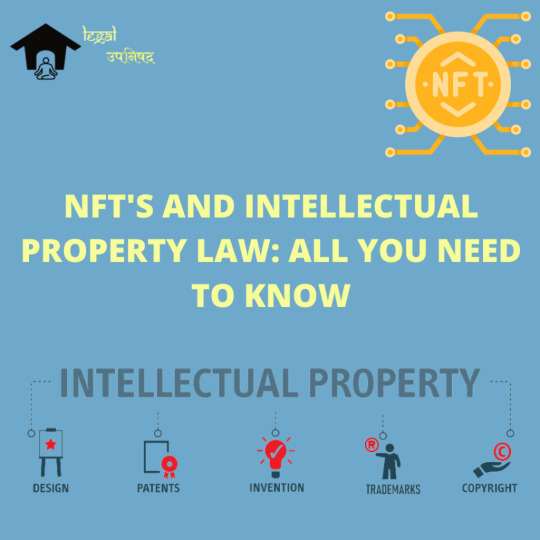
NFTs legality in India as per IPR: All You Need to Know
Suggestion
Misuse of an NFT or other IP connected to an NFT, you run a legal risk and can potentially be sued. Always beware that the work is not copyrighted content of another if you are an NFT author. Similarly, if you are an NFT holder, follow the rules that are there for your NFT to avoid infringement. Always be alert and avoid clicking on dubious sites as it could be malicious and harm or hack your device by disclosing your password, or through user error, your NFT could be taken. Technically, a hacker would need access to your wallet in order to steal your NFT; otherwise, they would just be pulled out of thin air. With the advancement in technology, NFT can be stolen in several ways.
Conclusion
Therefore, it is crucial to make a distinction between both the sovereignty of the NFT and the IP that supports it when looking at the property rights implications of NFTs. The powers given through a license or assignment can differ from one NFT to the next, determining the rights provided by an NFT seller. India ought to take inspiration from nations with well-balanced legal and regulatory systems to reduce loopholes and avoid infringement of the rights of the author. NFTs do have advantages and disadvantages. The disadvantage is that there is no stability, and the public is concerned that the NFTs are blatantly overstated as well as the possibility that the NFT market might collapse.
Reference
- Bipul Kumar, 6th June, 2022, at:- https://www.khuranaandkhurana.com/2022/06/06/nfts-and-indian-law/ - ,September 5, 2022 https://blog.ipleaders.in/is-nft-legal-in-india/#:~:text=TradinginNFTswouldbe,onarecognisedstockexchange. - Pravertna Sulakshya, Khurana and Khurana, 17 November 2021, at: https://www.mondaq.com/india/fin-tech/1132188/nft-and-its-relationship-with-ipr Read the full article
#Copyright#Intellectualpropertyrights#IPR#LawsinIndia#NFT#NFTs#non-fungibletokens#TRADEMARKS#TRADEMARKSININDIA
4 notes
·
View notes
Text
Enfhess v1.0 - NFT Marketplace HTML Template
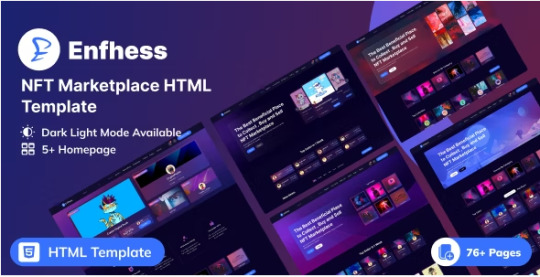
Enfhess is the most complete template for NFT marketplace, crypto-collectibles, digital items, non-fungible tokens websites, and more. Enfhess is a responsive, pixel-perfect and has a lot of styled elements to help you make beauty and modern website in no time. Read the full article
#bitcoin#blockchain#crypto#cryptocollectibles#cryptocurrency#digitalart#digitalasset#digitalitems#Enfhess-NFTMarketplaceHTMLTemplate#EnfhessNFT#HTMLTemplate#market#nft#nftsmarketplace#non-fungibletokens#virtualasset#wallet
2 notes
·
View notes
Photo

However, if you do want to invest or create it is always good to know a little about the types of digital assets that are available on the market. Not all of them are available as NFTs yet but due to the lack of a structured framework there is complete freedom to explore.
0 notes
Text
Demystifying the Technicalities of Rendering Tokenized Generative Art
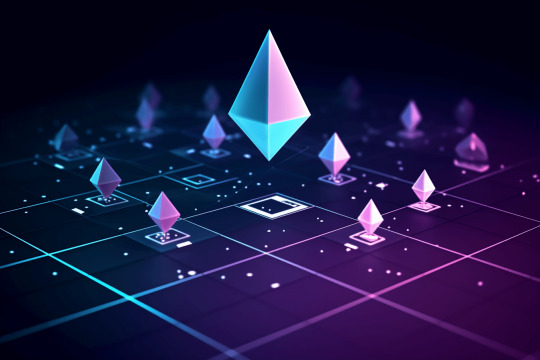
Art and technology have been gradually intertwining over the years, culminating in the emergence of tokenized generative art. It’s a fascinating convergence of creativity and computer science, involving the use of algorithms for art creation and blockchain technology for tokenization and provenance tracking. This article aims to break down the complex technicalities behind rendering tokenized generative art.
1. An Overview of Tokenized Generative Art
Tokenized generative art involves the creation of unique digital artworks through an algorithm or code, and then representing these pieces as distinct, non-fungible tokens (NFTs) on a blockchain, most commonly Ethereum. This novel approach allows artists to create a multitude of unique pieces, each represented by a distinct token with provable ownership and authenticity.
2. The Art of Generation: Programming and Libraries
Generative art is created through algorithms, essentially pieces of code that generate unique outputs based on certain parameters and randomness. Artists often use programming languages like Python or JavaScript and employ various libraries such as p5.js, Three.js, or TensorFlow.js to create visually diverse and intriguing pieces of artwork. The element of randomness and the use of mathematical constructs often leads to aesthetically pleasing patterns and structures. The algorithm might incorporate randomness in the form of color, shape, positioning, or a host of other parameters, all while keeping within certain aesthetic bounds defined by the artist.
3. Tokenization: Solidity and Smart Contracts
Once the artwork has been generated, each piece is tokenized, typically on the Ethereum blockchain. Tokenization involves creating a unique digital token for each artwork, which is carried out through the deployment of a smart contract. Solidity, Ethereum's programming language, is used to write this smart contract. These contracts usually adhere to the ERC-721 standard for NFTs, which defines a minimal interface allowing for the management, ownership, and transfer of unique tokens. The contract includes functions for minting (creating) new tokens, and each minted token is associated with a specific piece of artwork.
4. IPFS and Metadata
The connection between the token and its corresponding artwork is established through the token's metadata. This metadata typically includes details about the art piece and a URL pointing to the artwork file. To ensure the persistence of the artwork over time, the art files are usually stored on the InterPlanetary File System (IPFS), a decentralized storage system. The IPFS hash of the file is then stored in the token's metadata, creating an immutable link between the token and the artwork.
5. Rendering Tokenized Art: Interacting with the Blockchain
With the tokenization complete, the next step is to render or display the tokenized art. This involves developing a frontend application that can interact with the blockchain, read the metadata associated with each token, and display the artwork. Web3.js or Ethers.js are commonly used libraries to facilitate interaction with the Ethereum blockchain. These allow the application to connect to a user's Ethereum wallet, query the blockchain for the tokens owned by the user, and retrieve the token's metadata. This metadata is then used to fetch and display the actual artwork from its storage location.
6. The Marketplace: Buying, Selling, and Trading
Once the artwork has been tokenized and rendered, it can be bought, sold, or traded on any marketplace that supports the ERC-721 standard, such as OpenSea or Rarible. Each transaction is recorded on the Ethereum blockchain, providing a transparent and immutable history of ownership.
7. Generating New Tokens for Each Art Variant
One of the fascinating aspects of generative art lies in its ability to generate countless unique variants of a base artwork. Each variant is typically defined by certain variables, which might include aspects like color, shape, size, pattern, or any other parameter defined in the generation algorithm. This ability to create multiple unique pieces lends itself naturally to the concept of tokenization, where each distinct piece of artwork can be represented by a unique token. In the context of Ethereum and the ERC-721 standard, each unique piece of generative art (variant) can be associated with a distinct token. This involves extending the minting function within the smart contract. Here's a simple example using Solidity: pragma solidity ^0.5.0; import "@openzeppelin/contracts/token/ERC721/ERC721.sol"; contract MyNFT is ERC721 { uint256 public tokenCounter = 0; constructor() ERC721("MyNFT", "MNFT") public {} function mintArt(address to) public { uint256 newArtTokenId = tokenCounter; _mint(to, newArtTokenId); tokenCounter++; } } In the example above, tokenCounter is used to ensure each new piece of art gets a unique token ID. The mintArt function creates a new token with a unique ID and assigns it to the given address. This function can be called each time a new variant of the artwork is created, thus tokenizing each unique piece of generative art. It's important to note that the metadata for each token would also need to be unique to represent the unique artwork it is associated with. The metadata could include details about the variables that define the variant, along with the URL of the artwork file. Just as with the base artwork, each new variant could be stored on IPFS or another decentralized file storage system, and the URL of this stored file would be included in the metadata of the associated token. This allows each tokenized variant to be rendered individually, showcasing the unique features of each piece. In this way, not only can the original, base artwork be tokenized and rendered, but every single unique variant generated by the algorithm can be given its own representation on the blockchain, complete with its own provenance and ownership record. This significantly extends the potential for interaction, trading, and appreciation of the unique aspects of each variant within the broader generative art piece. In conclusion, while the technicalities of rendering tokenized generative art may initially appear complex, they essentially boil down to three main components: the generation of the art, the tokenization of the art, and the rendering of the tokenized art. By leveraging coding, blockchain, and decentralized storage, artists and developers are able to create, tokenize, and display unique pieces of digital artwork, pushing the boundaries of what's possible at the intersection of art and technology. Read the full article
#blockchain#decentralizedstorage#ERC-721Standard#Ethereum#generativeart#IPFS#Non-FungibleTokens#smartcontracts#Solidity#tokenization
0 notes
Link
#nft#nftart#nftcreator#nftdevelopment#nfteducation#nftgenerator#nftguide#nftguides#nftindustry#nftminting#nftwebsite#non-fungibletokens
0 notes
Text
Play ball!

Sairaj Iyer finds out if 'gully cricket' can leverage technology to give IPL a run for its money. Read More. https://www.sify.com/technology/play-ball/
#IndianPremierLeague#IPL#GullyCricket#NLP#NaturalLanguageProcessing#Wicket#NFTs#Non-FungibleTokens#Tennis-BallCricket#MetaverseIPL
0 notes
Text
Bitcoin Dominance Surges: A Shift in Market Sentiment Favors the Original Cryptocurrency
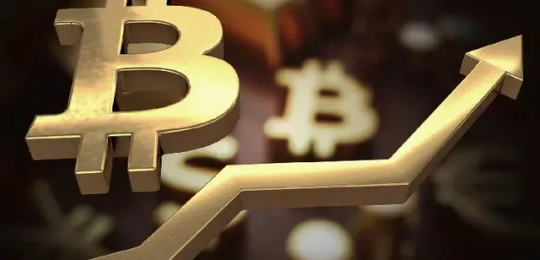
Bitcoin's dominance on the global cryptocurrency market is surging, hinting at a potential shift in market sentiment that favors the original digital currency. This surge is reflected in a crucial metric that compares Bitcoin's market capitalization to the total value of all cryptocurrencies. After bouncing back above 50%, Bitcoin dominance is on track to reach a significant milestone of 70%.
Bitcoin's Resilience Against Altcoins
Tracing Bitcoin's dominance over the past decade reveals a remarkable pattern of resilience in the face of a growing number of competing cryptocurrencies, commonly known as altcoins. Even with the emergence of altcoins such as Litecoin and Ripple-affiliated XRP between 2011 and 2013, Bitcoin managed to maintain near-total dominance at around 95%. Despite challenges posed by Ethereum's launch in 2015 and the subsequent influx of initial coin offerings (ICOs) during 2017-2018, Bitcoin sustained its dominant market position. Although its dominance temporarily declined to a record low of 37% in January 2018 due to the ICO boom, it rebounded and surpassed the 50% mark by the end of that year.
The Rise of DeFi and NFTs
In recent years, the cryptocurrency market has witnessed a significant expansion of decentralized finance (DeFi) and non-fungible tokens (NFTs). Many of these innovative projects are built on competing blockchains like Ethereum and Solana. Consequently, Bitcoin's dominance experienced a decline, reaching 39% by mid-2021.
Bitcoin Dominance Reasserts Itself
However, since November 2021, Bitcoin dominance has found its footing once again, embarking on an upward trend. As of June 20, it has crossed the 50% mark for the first time since April 2021. This resurgence in Bitcoin dominance indicates a renewed confidence in the original cryptocurrency.
Bitcoin Outperforming Altcoins
Recent data from CoinGecko supports the notion that Bitcoin is outperforming altcoins on a weekly basis. This outperformance serves as a testament to the resilience and strength of Bitcoin, especially in a market characterized by the volatility of alternative cryptocurrencies. With its market capitalization reaching an impressive $519 billion and a weekly growth rate of 2.8%, Bitcoin stands tall amid market fluctuations.
Conclusion
Bitcoin's dominance in the cryptocurrency market is charging towards a key milestone, signaling a significant shift in market sentiment favoring the original digital currency. Over the years, Bitcoin has showcased its resilience against a growing number of altcoins, maintaining a strong market position despite challenges. As decentralized finance (DeFi) and non-fungible tokens (NFTs) gained traction, Bitcoin's dominance temporarily declined. However, recent trends indicate a resurgence in Bitcoin dominance, with the cryptocurrency outperforming its competitors on a weekly basis. With its market capitalization and growth rate, Bitcoin continues to exhibit its strength and stability amidst market uncertainties. For more articles visit: Cryptotechnews24 Source: u.today
Latest Posts
Read the full article
#Altcoins#Bitcoindominance#CoinGecko#CryptoNews#cryptocurrencymarket#decentralizedfinance(DeFi)#Ethereum#marketcapitalization#marketsentiment#non-fungibletokens(NFTs)#outperforming#resilience#volatility
1 note
·
View note